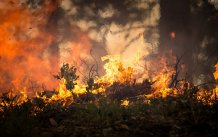Articles

It’s important to consider "regional details" as well as global averages, researchers say
Geoengineering risks losers as well as winners for climate and wildfire risks
Artificially altering the climate system to limit global warming to 1.5C could increase the risks of wildfires in some areas, new research suggests.
While the international community is already aiming to limit global warming to below 2C by reducing greenhouse gas emissions, the more ambitious aim of a 1.5C limit is known to be challenging to reach in this way.
An additional method to further limit warming might be to release sulphur dioxide high in the atmosphere, to produce a thin veil of droplets that would reflect some sunlight back to space and help keep the Earth cool.
However, the new research suggests that this method of geoengineering could also introduce its own new impacts by shifting global rainfall patterns.
The research by scientists at the University of Exeter and the Met Office Hadley Centre, carried out as part of the EU-funded project HELIX, looked at the implications of this for global patterns of wildfire using computer models of the global climate.
Their simulations suggested that, while the cooler global temperatures would overall lead to lower fire risk at 1.5C global warming compared to 2C, some regions would actually see an increase in fire risk because of drier and warmer conditions locally.
Lead author Chantelle Burton, of the University of Exeter, said: “This illustrates the complexity of actively trying to change the climate, rather than simply reducing our influence on it. Interventions meant to reduce impacts could actually increase the impacts for many people.”
In the models, most parts of the world saw 30 fewer days per year with high fire risk.
However, up to 31 more days with high fire risk were seen in parts of North and South America, east and south Asia and southern Africa.
Professor Richard Betts, a co-author of the study and director of the HELIX project, said: “It is clear that overall there are benefits to limiting global warming.
“However, it’s important to look beyond simply global average temperatures and consider the regional details, especially if more radical measures such as geoengineering were ever to be considered.
“If interventions led to losers as well as winners, how would we deal with the ethics of this?”
The paper, published in the journal Geophysical Research Letters, is entitled: “Will fire danger be reduced by using solar radiation management to limit global warming to 1.5°C compared to 2.0°C?”
Date: 9 April 2018
